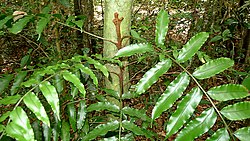| Lomariopsis marginata | |
|---|---|
 | |
| Scientific classification | |
| Kingdom: | Plantae |
| Clade: | Tracheophytes |
| Division: | Polypodiophyta |
| Class: | Polypodiopsida |
| Order: | Polypodiales |
| Suborder: | Polypodiineae |
| Family: | Lomariopsidaceae |
| Genus: | Lomariopsis |
| Species: | L. marginata |
| Binomial name | |
| Lomariopsis marginata (Schrad.) Kuhn [1] | |
| Synonyms [1] | |
| |
Lomariopsis marginata is a fern in the family Lomariopsidaceae. It is native to Brazil and possibly French Guiana. [1]